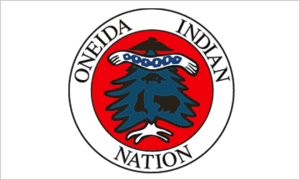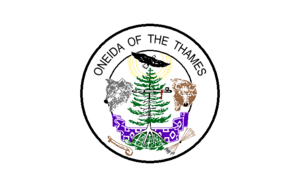Oneida people facts for kids
| Total population | |
|---|---|
| 15,388 | |
| Regions with significant populations | |
| 10,309 and 1,109 | |
| 3,970 | |
| Languages | |
| Oneida, English, other Iroquoian Languages | |
| Religion | |
| Kai'hwi'io, Kanoh'hon'io, Kahni'kwi'io, Christianity, Longhouse (Handsome Lake), Other Indigenous Religion | |
| Related ethnic groups | |
| Seneca Nation, Onondaga Nation, Tuscarora Nation, Mohawk Nation, Cayuga Nation, other Iroquoian peoples | |

The Oneida people (who call themselves Onʌyoteˀa·ká·, meaning "People of the Upright Stone") are a Native American tribe. They are also known as First Nations in Canada. They were one of the five original groups of the powerful Iroquois Confederacy. This confederacy was formed in what is now upstate New York, near the Great Lakes.
The Oneida originally lived in central New York, around Oneida Lake. Today, there are four recognized Oneida nations. Two are in the United States: the Oneida Indian Nation in New York and the Oneida Nation near Green Bay, Wisconsin. Two are in Ontario, Canada: Oneida at Six Nations of the Grand River and Oneida Nation of the Thames in Southwold.
Template:TOC limit=3
Contents
The People of the Standing Stone
The name Oneida comes from their own name for themselves, Onyota'a:ka. This means "People of the Standing Stone." This name comes from an old story.
The legend says that the Oneida people were being chased by an enemy tribe. As their enemies followed them into a forest clearing, the Oneida suddenly vanished! The enemies could not find them. It was said that the Oneida had turned into the stones standing in the clearing. Because of this, they became known as the People of the Standing Stone.
Older stories also call the Oneida Latilutakówa, or "Big Tree People." Not much is written about this. It might connect to the Iroquois idea of the Tree of Peace.
Oneida people are identified by their spirit name, their clan, and their family within that clan. The Oneida have a matrilineal system. This means children belong to their mother's clan. Family status and inheritance pass through the mother's side. Each gender, clan, and family has special duties in the tribe. The clans go back to the Oneida Creation Story. The Oneida people belong to three main clans: the Wolf, Turtle, or Bear clans. Since children get their social status from their mother's clan, her oldest brother is very important to the children. He especially helps boys become men.
Oneida History
Homeland Boundaries
In the early 1600s, the Oneida people lived on about 6 million acres of land. This land is now central New York State. Official borders were set in the 1768 Treaty of Fort Stanwix. Later, in 1784, New York Governor George Clinton asked the Oneida to define their land borders again. These were set in the Treaty of Fort Stanwix (1784).
Role in the American Revolution
At first, the Oneida and the other five Iroquois tribes tried to stay neutral in the American Revolution. This gave them power, as they could threaten to join either side. But neutrality soon broke down. Most of the Mohawks, Senecas, Cayugas, and Onondagas sided with the British. The Oneida tried to keep peace among the tribes.
However, the Oneida also had to choose a side. Most Oneida supported the American rebels. This was partly because they lived close to rebel communities. Also, the Presbyterian missionary Samuel Kirkland had worked with them since 1764. Many Oneida became Christians and formed strong ties with the colonists.
The Oneida officially joined the rebels. They helped a lot in the war. Their warriors often scouted for the Americans. They also kept communication open between the rebels and other Iroquois tribes. In 1777, at the Battle of Oriskany, about fifty Oneida fought with the colonial army. This included Tyonajanegen and her husband Han Yerry.
Many Oneida became friends with important rebel leaders like George Washington and Marquis de Lafayette. Polly Cooper, an Oneida woman, traveled to Valley Forge in 1777. Under Chief Skenandon's leadership, the Oneidas brought corn to General Washington's hungry army. Cooper showed them how to cook it. Washington offered her money, but she refused, saying it was her duty. As thanks, Martha Washington bought Cooper a shawl, hat, and bonnet.
Even though tribal leaders chose the rebel side, some Oneida individuals made their own choices. A small group supported the British. As the war got harder for the Oneida, more people joined this group. When rebels destroyed the Oneida settlement at Kanonwalohale, many Oneida left the rebels. They moved to Fort Niagara for British protection.
Treaties and Land Loss
After the war, American settlers often attacked the Oneida. They did not care if the Oneida had been allies or enemies. In 1794, the Oneida and other Haudenosaunee nations signed the Treaty of Canandaigua with the United States. They were given 6 million acres of land, mostly in New York. This was one of the first Indian reservations in the U.S. But later treaties and actions by New York State greatly reduced their land to just 32 acres.
Moving to Wisconsin and Canada
The Oneida had to share land at the Onondaga Reservation. They did not have their own land. In the 1820s and 1830s, many Oneida moved to Wisconsin. There, they could buy land. Others moved to Canada. This happened because the United States was pushing for Indian removal from eastern states. Settlers kept moving onto their lands.
In 1838, Daniel Bread (1800-1873) helped the Oneida in Wisconsin make a treaty. This treaty said they wanted to own their land together as a community. The U.S. government had already reduced their land, just as it had for other tribes.
Oneida Land Claims
After Daniel Bread died in 1873, Cornelius Hill became Chief. For decades, he fought against moving the Oneida again. He also fought against turning common lands into private property. This was part of the Dawes Act of 1887. Hill was based in Wisconsin and died in 1907. After his death, William Rockwell led the Oneida in New York from about 1910 to 1960.
Oneida women activists worked hard on tribal land claims in the early 1900s. Laura "Minnie" Cornelius Kellogg and her husband, along with Mary Cornelius Winder and her sister Delia Cornelius Waterman, were very important. They pushed for land claims from 1920 onwards. They worked from their homes in New York and Wisconsin. After the Indian Reorganization Act of 1934, the Oneida in New York and Wisconsin worked together on their land claim. At that time, the remaining Oneida in New York had no land of their own.
They were encouraged by the Indian Claims Commission Act of 1946. Before this, they could not sue the U.S. government.
In the 1970s, the Oneida Indian Nation of New York, the Oneida Nation of Wisconsin, and the Oneida Nation of the Thames filed lawsuits. They wanted to get back land that New York had taken without Congress's approval. In 1998, the United States joined the lawsuits to help the Oneida.
More recent court cases have made the split between the Oneida in New York and Wisconsin clearer. The Oneida of Wisconsin have sued to get back lands in their old homelands. This is part of settling the lawsuits mentioned above.
Oneida Diet and Food
The Oneida people used the land by "eating the seasons." In autumn, they dried fruits and vegetables for winter. They also preserved meats like deer, geese, duck, and raccoon by drying them or using salt. Eating these meats in fall helped them store fat for winter.
Their diet also included nuts like hickory, black walnuts, and chestnuts. These nuts gave them protein and fat. They also dried wild rice, which grew in swampy areas. Wild rice was a source of energy.
When spring arrived, their diet changed. They would boil and eat wild onions, leeks, and dandelions. Spring was also when they started fishing. They caught trout, walleye, pike, bass, and salmon. Maple trees provided sap, which they boiled down to make syrup and hard candy. The maple candy was eaten or saved to flavor other foods.
In summer, the Oneida ate many fruits. These included strawberries, blackberries, raspberries, blueberries, pears, plums, peaches, apples, and grapes. They also used sassafras to make tea.
Oneida Dancing
There are two types of Oneida dancing: social and ceremonial. Social dancing is for everyone to enjoy. Examples include the round dance, rabbit dance, old moccasin dance, and canoe or fishing dance.
Ceremonial dancing is sacred. It is only performed privately in the longhouses. Examples are the Maple Syrup, Strawberry, Bean, Sun, and Moon dances. Singing is part of ceremonial dancing, but they only chant during social dances. Each song has an introduction. When the beat changes, the dancing begins. Drums give signals to dancers when to switch partners. If someone was asked to dance but refused, they would offer tobacco as a sign of respect.
Traditional Clothing
Clothing is very important in Oneida culture. It shows who they are. Before meeting Europeans, the Oneida used only natural materials. They stitched clothing from deer and other animal hides. When Europeans arrived, trading began. Their clothing then started to be made from cotton fabrics like calico and broadcloth. This style has continued for hundreds of years. The Oneidas typically wore moccasins on their feet. Even with new materials, the basic design of their outfits stayed the same.
Headwear
Oneida men and women wore different headwear. Men wore traditional Iroquois headdresses called kastoweh. These had feathers and symbols representing their tribe. The Oneida Nation's symbol is three eagle feathers: two standing straight up and one pointing down. Oneida women wore beaded tiaras. The beadwork on the tiaras often showed woodland designs, representing their nation.
Recognized Oneida Nations
- Oneida Indian Nation in New York
- Oneida Nation of Wisconsin, in and around Green Bay, Wisconsin
- Oneida Nation of the Thames in Southwold, Ontario
- Oneida at Six Nations of the Grand River, Ontario
Education
The Oneida Nation School System in Wisconsin is a tribal school for students from kindergarten through 12th grade.
Notable Oneida People
- Aaliyah, American singer, of Oneida and African-American descent.
- Carl J. Artman, Assistant Secretary of the Bureau of Indian Affairs.
- Daniel Bread (1800-1873), a main chief of the Oneida.
- Polly Cooper, a leader who brought white corn to General Washington's troops at Valley Forge in 1777-1778. She taught them how to cook it.
- Cora Elm (1891-1949), an American nurse in France during World War I.
- Graham Greene, actor.
- Charlie Hill, comedian and entertainer.
- Laura "Minnie" Cornelius Kellogg, an activist in Oneida land claims in the early 1900s.
- Lillie Rosa Minoka Hill, a Mohawk doctor in the 1900s. She was adopted by the Oneida for her work with them.
- Cody McCormick, Canadian professional ice hockey player.
- Skenandoa, a chief and leader during the American Revolution; an ally of the Americans.
- Joanne Shenandoah, an award-winning singer.
- Dennison Wheelock, a composer, conductor, and cornet soloist from the late 1800s and early 1900s.
- Tyonajanegen, a leader who fought in the Battle of Oriskany with her husband Han Yerry.
- Ray Halbritter, leader of the Oneida Indian Nation since 1975.
- Nyla Rose, professional wrestler.
- Neilson Powless, professional cyclist (competed in the 2020 Tour de France).
See also
 In Spanish: Oneida para niños
In Spanish: Oneida para niños



